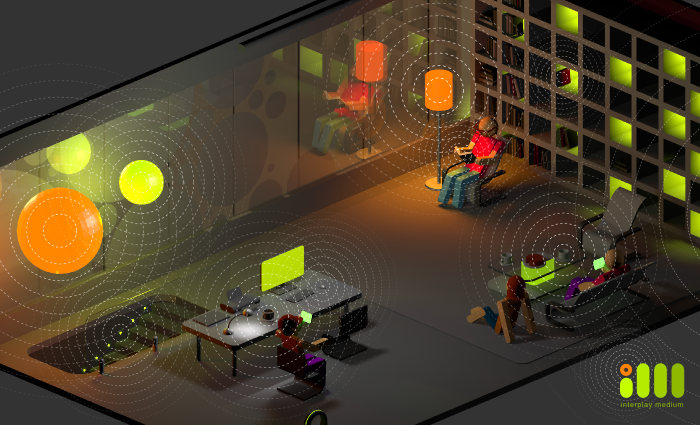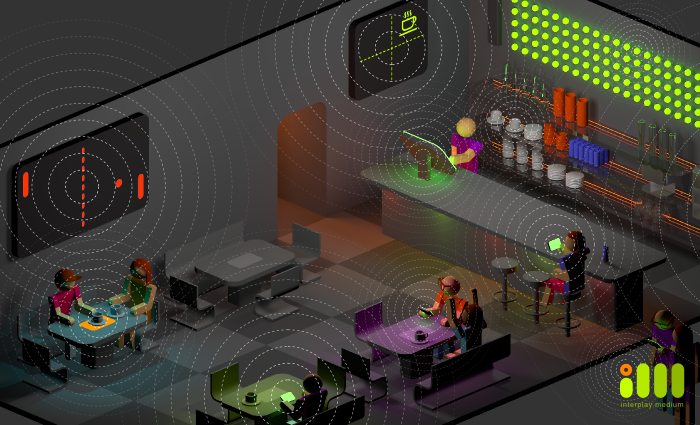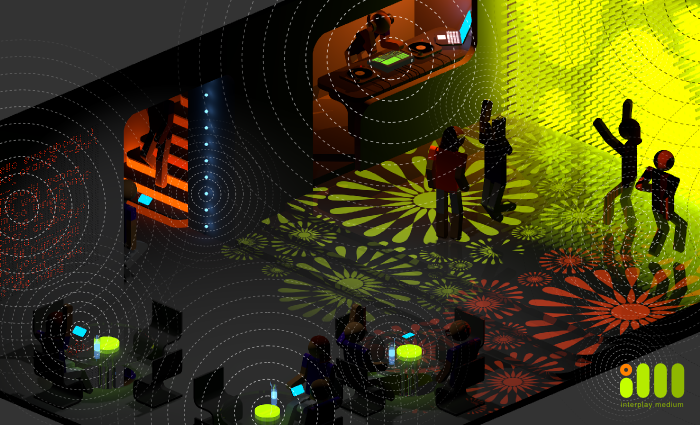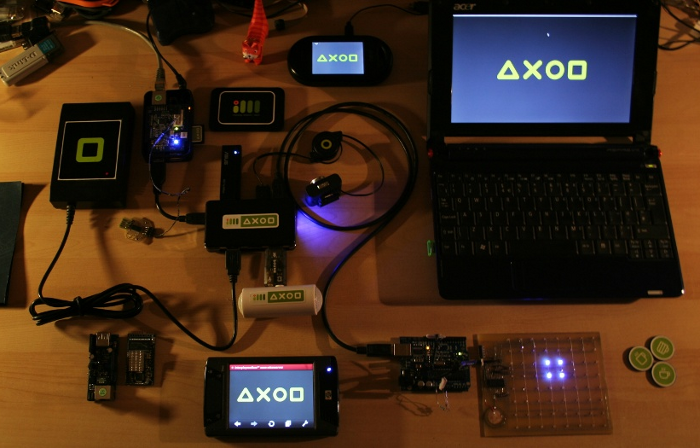Interplay medium
Hello friends.
I want to share with you a story about one of my other projects, Interplay Medium, which I mentioned in passing in my previous article about the Prague electronic audio guide and which I have been slowly studying for the last four years. This time it will be about a non-commercial project and designed primarily for the public, on the one hand, not alien to the development of electronics, on the other, interested in all sorts of aesthetic practices that at first glance are not related to electronics.
This story, perhaps, it makes sense to split into several parts. The first part will be more philosophical in nature, in it I will try to reveal the general background and the main idea of the project. In the future, I will talk about the architecture of the whole venture, and then I will, as far as I can, share specific step-by-step descriptions of simple implementations, which, in turn, can be useful for designers and developers who wish to use my ideas in their own projects.
')
The text below is partly a translation of my own text in English posted on the website of my project, however, does not copy it in its entirety (I am not sure that this is possible here, so I apologize in advance, moderators, do not hit! My own original text).
We live in an era of technological and information boom, the true meaning and perspectives of which are just beginning to acquire the first meaningful outlines. The availability of computer tools and the emergence of a global information infrastructure has become a prerequisite for changing the very idea of communication. Computer technology has grown its infancy and has evolved from a simple means of algorithmization and analysis into an everyday tool of communication and cooperation. In the end, a large number of available devices appeared, allowing for a new level of information exchange and organization. What awaits us next?

The idea that all human existence - the essence of the continuous reorganization of the surrounding reality is not new. Even Vitruvius, describing architectural principles, spoke about the creation of a structure as a transformation of basic elements of nature 1 , later the idea of reorganization in a broader sense found a response in aesthetics and philosophy of the Renaissance, and in the twentieth century embodied in the principles of theorists and practitioners of design 2 . Today we bring the concept of “design” to an even more abstract level, speaking about the organization of information in general - as the fundamental principle of all processes, not only in relation to the physical world but also at the level of abstract relations and categories.
Adaptation of electronics to our senses, to our nature, to our increasingly complex language, as well as the availability of tools, miniaturization and cheapening of the production of electronic components, and, ultimately, an understanding of the value of free information exchange opens up the prospects that we are today we can only guess. However, one thing is obvious - electronics, as an instrument, is just beginning its victorious march across the planet.
The emergence of open source hardware and copyleft electronics projects, a growing community of hacker enthusiasts who, using affordable, sometimes life-giving electronics, create systems with more sophisticated functionality than industrial developers intended - all of which are visible signs of technical fragmentation. progress and its output beyond the designated areas of automation of production and life. Electronics literally becomes not just a tool but the actual material of the artist, designer, creator.
We are accustomed to talk about composition (whether it is a graphic composition or architectural, literary or musical), as about building (collage) passive objects (fragments) that acquire a meaningful structure in our imagination by virtue of the laws of perception of form and color. We can talk about the interaction of objects within the composition at the level of color, mass relations, contrast of forms. We are used to setting some rules for organizing the composition that are familiar to our perception and to use all this as an expressive means. Today, our new electronic "senses" give us the opportunity to perceive and interact at a fundamentally new level. It's time to teach the world of objects a new language.

Imagine an interior or a whole landscape within which all objects exchange information about their own position and physical condition, as well as about each other and the environment. As a designer of the information environment, you can define the algorithmic logic of the interaction of objects, complementing the visible compositional logic of the organization of the architectural space. You, as a participant in the information environment, can interact with the environment and change the system parameters through any physical and virtual “interfaces” provided by the designer, using both the usual forms of physical interaction between objects, as well as interactions with the environment through personal devices (helpers).
In one form or another, any interaction with consumer or industrial automation is a special case of the implementation of this concept, for example: a “smart home” or building a city lighting system during day and night hours. However, all these systems are designed to no more than automate an already existing familiar process. Interplay medium implies the organization of interaction at a fundamentally different level - when the very method of organizing and the nature of data circulating in the local information space is presented as an expressive means.

The Interplay medium project offers a new concept of the organization of the environment, which includes, in addition to the classical expressive methods, an interactive and informational component, both at the object-person level and at the object-object and network-object-person levels.
Reflecting on the future of electronics and watching a lot of more and more interesting projects implemented by authors from related and sometimes not at all related to electronics fields, I recall the 80s. When specialists from seemingly completely different disciplines began to pay attention to computer technology. In the community of programmers appeared designers working with a digital image, musicians dealing with a synthesized sound. And later in the community of designers and animators began to appear programmers, trying their hand at interactive graphics. The fact that the most striking and interesting results of this strange symbiosis are made by interdisciplinary developers makes me believe that this kind of specialists will be able to (and are already doing) the first steps from the virtual world of flash, maxMSP, PureData and other intricate tools inside the computer physical reality. On the other hand, creators who previously did not deal with electronic technologies discover new opportunities opening up for working with microprocessor technology. Open the Make blog or go to the Arduino website and you will find hundreds of examples of such projects there.
In my opinion, the very moment comes when the development of interactive design goes beyond the virtual PC world and in the hands of creators acquires a new meaning in the physical world. The study of this new area, as well as the development of tools for this kind of projects, is the task that the interplay medium project currently sets itself.

This is how the prototype of the system, assembled on Bifferboard, looks . The AXOD microserver interface (aka Digital Axon) is open on three independent devices in the browser.
Interplay medium in its basic representation is a software and hardware complex designed for designers and developers who want to create systems of interactive objects, combined into a local infrastructure and subordinate to a single logic conceived by the author. On the basis of cheap devices like the Raspberry Pi, Bifferboard or even an ordinary household router, the developer can build a complete system for managing the logic of disparate objects. And having knowledge in the field of electronics creation, the author can create his own interactive objects and integrate them into the local infrastructure Interplay medium he created.
In this place, I, with your permission, interrupt my story, as long as this is more than enough for an intriguing preamble, and my fingers already require a thorough rest. In the next posting (which I will try to prepare somewhere in a week and a half), I will tell you about the architecture of the whole venture and briefly describe how the central element of the system looks from the inside - the AXOD microserver (aka Digital Axon).
Links, again, do not give, as long as the rules prohibit. However, I think that if someone becomes interested, it will not be a problem to find the project site by name.
1 - Marcus Vitruvius Pollio: de Architectura, Book I, Chapter 4, I BCE.
2 - For example, Frank Lloyd Wright in his works consistently inspired the idea of building "growing out" of the natural environment and "embedded" in it, which later formed as the style of "Organic Architecture". Ludwig Mies van der Rohe, as a follower of Neo-Tomism, was guided in his designs by the ideas of Aristotle on four proto-elements.
I want to share with you a story about one of my other projects, Interplay Medium, which I mentioned in passing in my previous article about the Prague electronic audio guide and which I have been slowly studying for the last four years. This time it will be about a non-commercial project and designed primarily for the public, on the one hand, not alien to the development of electronics, on the other, interested in all sorts of aesthetic practices that at first glance are not related to electronics.
This story, perhaps, it makes sense to split into several parts. The first part will be more philosophical in nature, in it I will try to reveal the general background and the main idea of the project. In the future, I will talk about the architecture of the whole venture, and then I will, as far as I can, share specific step-by-step descriptions of simple implementations, which, in turn, can be useful for designers and developers who wish to use my ideas in their own projects.
')
The text below is partly a translation of my own text in English posted on the website of my project, however, does not copy it in its entirety (I am not sure that this is possible here, so I apologize in advance, moderators, do not hit! My own original text).
Preamble
We live in an era of technological and information boom, the true meaning and perspectives of which are just beginning to acquire the first meaningful outlines. The availability of computer tools and the emergence of a global information infrastructure has become a prerequisite for changing the very idea of communication. Computer technology has grown its infancy and has evolved from a simple means of algorithmization and analysis into an everyday tool of communication and cooperation. In the end, a large number of available devices appeared, allowing for a new level of information exchange and organization. What awaits us next?
Human Generated Environment

The idea that all human existence - the essence of the continuous reorganization of the surrounding reality is not new. Even Vitruvius, describing architectural principles, spoke about the creation of a structure as a transformation of basic elements of nature 1 , later the idea of reorganization in a broader sense found a response in aesthetics and philosophy of the Renaissance, and in the twentieth century embodied in the principles of theorists and practitioners of design 2 . Today we bring the concept of “design” to an even more abstract level, speaking about the organization of information in general - as the fundamental principle of all processes, not only in relation to the physical world but also at the level of abstract relations and categories.
Adaptation of electronics to our senses, to our nature, to our increasingly complex language, as well as the availability of tools, miniaturization and cheapening of the production of electronic components, and, ultimately, an understanding of the value of free information exchange opens up the prospects that we are today we can only guess. However, one thing is obvious - electronics, as an instrument, is just beginning its victorious march across the planet.
The emergence of open source hardware and copyleft electronics projects, a growing community of hacker enthusiasts who, using affordable, sometimes life-giving electronics, create systems with more sophisticated functionality than industrial developers intended - all of which are visible signs of technical fragmentation. progress and its output beyond the designated areas of automation of production and life. Electronics literally becomes not just a tool but the actual material of the artist, designer, creator.
Interplay medium
We are accustomed to talk about composition (whether it is a graphic composition or architectural, literary or musical), as about building (collage) passive objects (fragments) that acquire a meaningful structure in our imagination by virtue of the laws of perception of form and color. We can talk about the interaction of objects within the composition at the level of color, mass relations, contrast of forms. We are used to setting some rules for organizing the composition that are familiar to our perception and to use all this as an expressive means. Today, our new electronic "senses" give us the opportunity to perceive and interact at a fundamentally new level. It's time to teach the world of objects a new language.

Imagine an interior or a whole landscape within which all objects exchange information about their own position and physical condition, as well as about each other and the environment. As a designer of the information environment, you can define the algorithmic logic of the interaction of objects, complementing the visible compositional logic of the organization of the architectural space. You, as a participant in the information environment, can interact with the environment and change the system parameters through any physical and virtual “interfaces” provided by the designer, using both the usual forms of physical interaction between objects, as well as interactions with the environment through personal devices (helpers).
In one form or another, any interaction with consumer or industrial automation is a special case of the implementation of this concept, for example: a “smart home” or building a city lighting system during day and night hours. However, all these systems are designed to no more than automate an already existing familiar process. Interplay medium implies the organization of interaction at a fundamentally different level - when the very method of organizing and the nature of data circulating in the local information space is presented as an expressive means.

The Interplay medium project offers a new concept of the organization of the environment, which includes, in addition to the classical expressive methods, an interactive and informational component, both at the object-person level and at the object-object and network-object-person levels.
Interactive Designers
Reflecting on the future of electronics and watching a lot of more and more interesting projects implemented by authors from related and sometimes not at all related to electronics fields, I recall the 80s. When specialists from seemingly completely different disciplines began to pay attention to computer technology. In the community of programmers appeared designers working with a digital image, musicians dealing with a synthesized sound. And later in the community of designers and animators began to appear programmers, trying their hand at interactive graphics. The fact that the most striking and interesting results of this strange symbiosis are made by interdisciplinary developers makes me believe that this kind of specialists will be able to (and are already doing) the first steps from the virtual world of flash, maxMSP, PureData and other intricate tools inside the computer physical reality. On the other hand, creators who previously did not deal with electronic technologies discover new opportunities opening up for working with microprocessor technology. Open the Make blog or go to the Arduino website and you will find hundreds of examples of such projects there.
In my opinion, the very moment comes when the development of interactive design goes beyond the virtual PC world and in the hands of creators acquires a new meaning in the physical world. The study of this new area, as well as the development of tools for this kind of projects, is the task that the interplay medium project currently sets itself.
Project

This is how the prototype of the system, assembled on Bifferboard, looks . The AXOD microserver interface (aka Digital Axon) is open on three independent devices in the browser.
Interplay medium in its basic representation is a software and hardware complex designed for designers and developers who want to create systems of interactive objects, combined into a local infrastructure and subordinate to a single logic conceived by the author. On the basis of cheap devices like the Raspberry Pi, Bifferboard or even an ordinary household router, the developer can build a complete system for managing the logic of disparate objects. And having knowledge in the field of electronics creation, the author can create his own interactive objects and integrate them into the local infrastructure Interplay medium he created.
In this place, I, with your permission, interrupt my story, as long as this is more than enough for an intriguing preamble, and my fingers already require a thorough rest. In the next posting (which I will try to prepare somewhere in a week and a half), I will tell you about the architecture of the whole venture and briefly describe how the central element of the system looks from the inside - the AXOD microserver (aka Digital Axon).
Links, again, do not give, as long as the rules prohibit. However, I think that if someone becomes interested, it will not be a problem to find the project site by name.
1 - Marcus Vitruvius Pollio: de Architectura, Book I, Chapter 4, I BCE.
2 - For example, Frank Lloyd Wright in his works consistently inspired the idea of building "growing out" of the natural environment and "embedded" in it, which later formed as the style of "Organic Architecture". Ludwig Mies van der Rohe, as a follower of Neo-Tomism, was guided in his designs by the ideas of Aristotle on four proto-elements.
Subject literature
- McLuhan Marshall, Understanding Media: The Extensions of Man ; 1st ed. McGraw Hill, NY, 1964
Surely familiar to the reader is the fundamental work of the famous Canadian philosopher, philologist and theorist of electronic means of communication. In his book, McLuhan describes the role of electronic media in modern society and tries to assess the degree and nature of their influence on a person. - Heidegger Martin, Die Frage nach der Technik // Die Kunste im technischen Zeitalter. Munchen, 1954
Speech of Heidegger in November 1953 in the Munich Higher Technical School as part of the readings “Art in the Technical Era” organized by the Bavarian Academy of Fine Arts. Reflections Heidegger on the role and purpose of technology in culture. - Moles Abraham, Théorie de l'information et perception esthétique, Paris, Denoël , 1973
One of the first and still few attempts to address issues of aesthetic perception from the point of view of mathematics, cognitive psychology and information theory. - Rob van Kranenburg, The Internet of Things 2008
The book is a Dutch cultural and literary critic and theorist of new media. In his book, Kranenburg tries to look into tomorrow's ambient technologies and the “all-seeing” networks day. It shares critical concerns about their development and, at the same time, focuses on emerging alternative trends in the development of these technologies and their impact on society.
The book was released under the creative commons license and can be downloaded from the Network Cultures website.
Source: https://habr.com/ru/post/149099/
All Articles